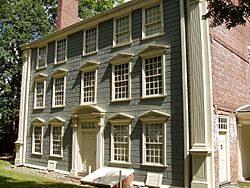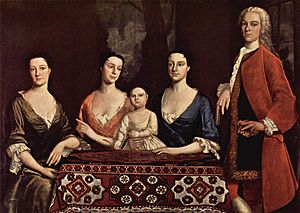Isaac Royall House facts for kids
|
Isaac Royall House
|
|

East (front) facade, built by Isaac Royall, Sr. over the original farmhouse
|
|
| Location | 15 George Street, Medford, Massachusetts |
|---|---|
| Built | 1732 |
| Architectural style | Georgian |
| NRHP reference No. | 66000786 |
Quick facts for kids Significant dates |
|
| Added to NRHP | October 15, 1966 |
| Designated NHL | October 9, 1960 |
The Isaac Royall House is a historic house located in Medford, Massachusetts, near Tufts University. The historic estate was founded by Bay Colony native Isaac Royall and is recognized as giving a face and life to the history and existence of slave quarters and slavery in Massachusetts. It is a National Historic Landmark, operated as a non-profit museum, and open for public visits between June 1 and the last weekend in October.
The Royall House is notable for its excellent preservation, its possession of the only surviving slave quarters in Massachusetts, and its American Revolution associations with General John Stark, Molly Stark, and General George Washington. Among the historic objects on display is a tea box, said to be from the same batch that was dumped into Boston Harbor on the night of December 16, 1773, and a very small painting by John Singleton Copley of Isaac Royall, Jr. The Royalls were the largest slave holding family in Massachusetts history.
Origins
Governor John Winthrop built a house on the site about 1637. Around 1692, that house was replaced with a more imposing brick structure standing 2½ stories high and one room in depth, with exceedingly thick walls. On December 26, 1732, Isaac Royall, Sr., a slave trader, rum distiller, and wealthy merchant of Antigua, purchased the house and 504 acres (2 km²) of land along the west bank of the Mystic River in what was then Charlestown, an area annexed to Medford in 1754. He remodeled the house extensively between 1733 and 1737, adding a third story, encasing the east facade in clapboard, and ornamenting the exterior with architectural details and continuous strips of spandrel panels. Royall also constructed outbuildings in 1732, including the only known slave quarters that survive in New England. After this construction, Royall brought 27 enslaved Africans from Antigua, which doubled the enslaved population of the community.
Early history
Isaac Royall, Jr. (1719–1781) came into its possession of the property in 1739 following the death of his father. He greatly enlarged it between 1747 and 1750. He more than doubled the depth of the main building, greatly extended the brick end walls correspondingly, and at either end of the house constructed great twin chimneys connected by parapets. Other features he added include the false ashlar siding on the new western facade and great Doric pilasters inserted at the corners. The interior was redone in Georgian wooden paneling, trim, and archways of a quality possibly unsurpassed by any surviving house of the period. Several of the major rooms that survive are original. He expanded a colonial farmhouse into a three story Georgian mansion considered one of the grandest houses of its era in North America. The construction process was largely borrowed from Caribbean construction practices.
A painting of Mary and Elizabeth Royall, the teenage daughters of Isaac Royall, Jr., executed by John Singleton Copley about 1758, is in the collection of the Museum of Fine Arts, Boston. A reproduction hangs in the Royall House. Copley also painted their father's portrait about 1769. An earlier family portrait from 1740 is in the Special Collections Department, Harvard Law School Library.
During the American Revolution, the Royall family were British Loyalists, and as the British soldiers marched to the Battle of Lexington and Concord in 1775, the Royalls left Medford and boarded a ship in Boston. They sailed to Halifax, Nova Scotia and then to England. Isaac Royall never returned to Medford.
After the Royalls' flight, the Massachusetts General Court confiscated the estate. General John Stark made the Royall House his headquarters before the evacuation of Boston by the British on March 17, 1776. The mansion was used during the early months of the Revolution by Generals Lee, Stark, and Sullivan. George Washington, according to legend, interrogated two British soldiers in the house's Marble Chamber. Molly Stark is said to have watched the movements of the British troops in their camp by the river from a lookout on the roof.
In 1806, the estate was returned to Isaac Royall's heirs, who sold it. In accordance with Isaac Royall's will, a portion of his estate was donated to Harvard University and used to found Harvard Law School.
Slave Quarters
The Slave Quarters were located in Medford 35 feet from the Royall House. There were more than 60 enslaved Africans who resided there over the 40 years.
When Sir Isaac Royall Sr. expanded the house in the 1730s, he adopted a practice from the Caribbean and build an "out kitchen," which was a detached kitchen meant to keep the heat away from the main house in the summer. In the 1760s, they added an clapboard extension which expanded the house and formed the original slave quarters.
The Slave Quarters had working and sleeping quarters, along with a summer kitchen. Today, you can take a tour of the Royall House finding a "kitchen chamber" where slaves worked and slept in a room on the second floor.
Preservation
In 1898, the Sarah Bradlee Fulton Chapter of the Daughters of the American Revolution conceived the idea of preserving the Royall House "for the sake of its history and aesthetic value." It was restored by Joseph Everett Chandler. On Patriots' Day in 1898, they opened the house to the public for a Loan Exhibition of colonial furnishings and valuable relics.
In 1907, this group of women recruited a wider group of "patriotic men and women" and formed the Royall House Association. The group's initial mission was to raise US$10,000 to purchase the house, the slave quarters and three-quarters of an acre of surrounding land to be maintained as a museum, which they accomplished by April 1908.
Over the years, the Royall House has undergone a number of interior and exterior restorations to its buildings and site. In 1960, the Royall House was designated a National Historic Landmark.
Images for kids







